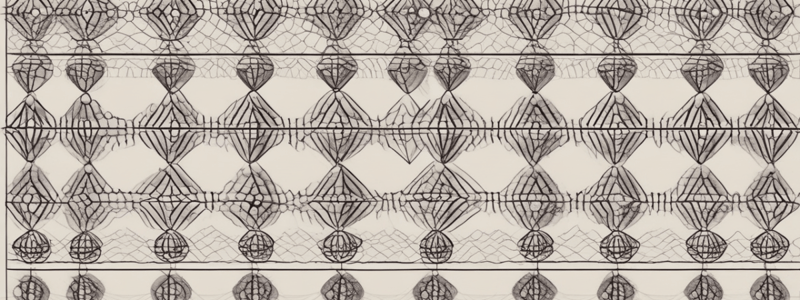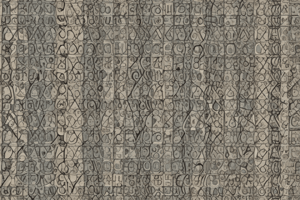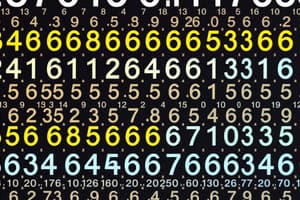Podcast
Questions and Answers
What is the new volume of a cylinder when the radius is multiplied by a factor of k?
What is the new volume of a cylinder when the radius is multiplied by a factor of k?
- $kV$
- $k^2V$ (correct)
- $k^3V$
- $k^2V_k$
If the height of a cylinder is multiplied by k, how does it affect the surface area?
If the height of a cylinder is multiplied by k, how does it affect the surface area?
- Surface area is divided by $k$
- Surface area is multiplied by $k$ (correct)
- Surface area is multiplied by $k^2$
- Surface area remains the same
What happens to the surface area of a cylinder if both the radius and height are multiplied by k?
What happens to the surface area of a cylinder if both the radius and height are multiplied by k?
- Surface area is multiplied by $k^3$ (correct)
- Surface area is multiplied by $k$
- Surface area is multiplied by $k^2$
- Surface area remains constant
In terms of the volume of a cylinder, what is the relationship when only the height is increased by a factor of k?
In terms of the volume of a cylinder, what is the relationship when only the height is increased by a factor of k?
If the radius of a cylinder is multiplied by k and then the height is unchanged, which of the following can be concluded about the volume?
If the radius of a cylinder is multiplied by k and then the height is unchanged, which of the following can be concluded about the volume?
What is the formula for the area of a triangle?
What is the formula for the area of a triangle?
How do you calculate the surface area of a cylinder?
How do you calculate the surface area of a cylinder?
Which of the following shapes is NOT classified as a right prism?
Which of the following shapes is NOT classified as a right prism?
Which formula represents the volume of a right prism?
Which formula represents the volume of a right prism?
What is the area formula for a circle?
What is the area formula for a circle?
What distinguishes a right pyramid from an ordinary pyramid?
What distinguishes a right pyramid from an ordinary pyramid?
How is the volume of a triangular prism calculated?
How is the volume of a triangular prism calculated?
Which definition best describes the surface area of a prism?
Which definition best describes the surface area of a prism?
What is the term used for an individual item in a sequence?
What is the term used for an individual item in a sequence?
Which of the following best describes a linear sequence?
Which of the following best describes a linear sequence?
In the general formula for a linear sequence, what does the variable 'd' represent?
In the general formula for a linear sequence, what does the variable 'd' represent?
What is the formula used to determine the common difference 'd' in a sequence?
What is the formula used to determine the common difference 'd' in a sequence?
What does the notation $T_n$ represent in a sequence?
What does the notation $T_n$ represent in a sequence?
If the first term of a linear sequence is 5 and the common difference is 3, what is the second term?
If the first term of a linear sequence is 5 and the common difference is 3, what is the second term?
Which statement is true about the area of a polygon?
Which statement is true about the area of a polygon?
Which of the following is NOT a key point about sequences?
Which of the following is NOT a key point about sequences?
What is the formula for the surface area of a right cone?
What is the formula for the surface area of a right cone?
How will the volume of a square pyramid change when all its dimensions are multiplied by a factor of 3?
How will the volume of a square pyramid change when all its dimensions are multiplied by a factor of 3?
What is the formula for the surface area of a sphere?
What is the formula for the surface area of a sphere?
What happens to the surface area of a rectangular prism when two dimensions are multiplied by 5?
What happens to the surface area of a rectangular prism when two dimensions are multiplied by 5?
What is the correct expression for the volume of a right cone?
What is the correct expression for the volume of a right cone?
When one dimension of a prism is multiplied by k, how is the volume affected?
When one dimension of a prism is multiplied by k, how is the volume affected?
For a triangular pyramid, what is the expression for its surface area?
For a triangular pyramid, what is the expression for its surface area?
If a sphere's radius is doubled, what is the factor by which its surface area increases?
If a sphere's radius is doubled, what is the factor by which its surface area increases?
What expression represents the volume of a triangular pyramid?
What expression represents the volume of a triangular pyramid?
What happens to the volume of a cylinder when both the radius and height are multiplied by a factor of k?
What happens to the volume of a cylinder when both the radius and height are multiplied by a factor of k?
How does the surface area of a cylinder change when only the radius is multiplied by k?
How does the surface area of a cylinder change when only the radius is multiplied by k?
If the height of a cylinder is doubled, which expression accurately represents the new surface area?
If the height of a cylinder is doubled, which expression accurately represents the new surface area?
What is the correct relationship between alterations in the height and volume of a cylinder when height is multiplied by k?
What is the correct relationship between alterations in the height and volume of a cylinder when height is multiplied by k?
Which statements correctly describe the effects of multiplying only the height of a cylinder by k?
Which statements correctly describe the effects of multiplying only the height of a cylinder by k?
What does the term 'common difference' in a sequence refer to?
What does the term 'common difference' in a sequence refer to?
In the general formula for a linear sequence, $T_n = dn + c$, what does the variable 'c' represent?
In the general formula for a linear sequence, $T_n = dn + c$, what does the variable 'c' represent?
How can the $n$th term of a linear sequence be expressed if the first term (
$T_1$
) is 2 and the common difference (d) is 5?
How can the $n$th term of a linear sequence be expressed if the first term ( $T_1$ ) is 2 and the common difference (d) is 5?
If the 4th term of a sequence is 26 and the common difference is 4, what is the first term?
If the 4th term of a sequence is 26 and the common difference is 4, what is the first term?
What is the formula used to calculate the common difference 'd' in a sequence?
What is the formula used to calculate the common difference 'd' in a sequence?
What defines a linear sequence?
What defines a linear sequence?
If a sequence progresses as follows: 4, 7, 10, ..., what is the common difference?
If a sequence progresses as follows: 4, 7, 10, ..., what is the common difference?
What denotes the notation $T_n$ in a sequence?
What denotes the notation $T_n$ in a sequence?
What is the surface area formula for a triangular prism?
What is the surface area formula for a triangular prism?
Which of the following shapes has a volume calculated by the formula $V = \pi r^2 h$?
Which of the following shapes has a volume calculated by the formula $V = \pi r^2 h$?
For a cube with a side length of $s$, how is the volume expressed?
For a cube with a side length of $s$, how is the volume expressed?
What defines a right prism?
What defines a right prism?
What is the area formula for a trapezium?
What is the area formula for a trapezium?
Which property is true for a right pyramid?
Which property is true for a right pyramid?
What is the circumference formula for a circle?
What is the circumference formula for a circle?
How is the volume of a right cone calculated?
How is the volume of a right cone calculated?
What is the surface area formula for a triangular pyramid?
What is the surface area formula for a triangular pyramid?
If the height of a square pyramid is multiplied by a factor of 2, by what factor does its volume change?
If the height of a square pyramid is multiplied by a factor of 2, by what factor does its volume change?
What is the relationship between the surface area and volume when all dimensions of a rectangular prism are multiplied by 3?
What is the relationship between the surface area and volume when all dimensions of a rectangular prism are multiplied by 3?
What is the surface area of a sphere with a radius of 4?
What is the surface area of a sphere with a radius of 4?
When only one dimension of a cone is multiplied by 4, how does its volume change?
When only one dimension of a cone is multiplied by 4, how does its volume change?
For a right cone, what is the surface area formula if the radius is $r$ and the height is $h$?
For a right cone, what is the surface area formula if the radius is $r$ and the height is $h$?
What is the volume of a triangular pyramid with a base area of 10 and height of 5?
What is the volume of a triangular pyramid with a base area of 10 and height of 5?
How does the surface area of a rectangular prism change when all three dimensions are multiplied by a factor of 2?
How does the surface area of a rectangular prism change when all three dimensions are multiplied by a factor of 2?
What is the volume formula for a sphere with radius $r$?
What is the volume formula for a sphere with radius $r$?
What characterizes a linear sequence regarding its terms?
What characterizes a linear sequence regarding its terms?
If the formula for a sequence is given by $T_n = 3n + 2$, what is the common difference?
If the formula for a sequence is given by $T_n = 3n + 2$, what is the common difference?
In a sequence where the first term is 10 and the common difference is -4, what is the 5th term?
In a sequence where the first term is 10 and the common difference is -4, what is the 5th term?
Which of the following statements is incorrect regarding the common difference in a sequence?
Which of the following statements is incorrect regarding the common difference in a sequence?
What is the general formula for the $n$th term of a linear sequence if the constant is -7?
What is the general formula for the $n$th term of a linear sequence if the constant is -7?
Given the sequence represented as 2, 5, 8, 11, ..., which term of the sequence corresponds to the value of 32?
Given the sequence represented as 2, 5, 8, 11, ..., which term of the sequence corresponds to the value of 32?
How do you determine the general term formula for a sequence starting at 7 with a common difference of 3?
How do you determine the general term formula for a sequence starting at 7 with a common difference of 3?
If a sequence is described as having a first term of 1 and a common difference of 0, what can be inferred about its terms?
If a sequence is described as having a first term of 1 and a common difference of 0, what can be inferred about its terms?
What is the formula for the volume of a right prism with a triangular base?
What is the formula for the volume of a right prism with a triangular base?
Which statement correctly describes the surface area calculation of a cylinder?
Which statement correctly describes the surface area calculation of a cylinder?
What distinguishes a right cone from other types of cones?
What distinguishes a right cone from other types of cones?
Which of the following statements about volume is true for right prisms?
Which of the following statements about volume is true for right prisms?
How is the area of a trapezium defined mathematically?
How is the area of a trapezium defined mathematically?
What is the key characteristic of a sphere regarding its dimensions?
What is the key characteristic of a sphere regarding its dimensions?
In the formula for the volume of a cylinder, which variable represents the height?
In the formula for the volume of a cylinder, which variable represents the height?
What characteristic defines a right pyramid?
What characteristic defines a right pyramid?
What is the factor by which the volume of a cylinder is changed when both the radius and height are multiplied by k?
What is the factor by which the volume of a cylinder is changed when both the radius and height are multiplied by k?
How does the surface area of a cylinder change when the height is doubled and the radius remains constant?
How does the surface area of a cylinder change when the height is doubled and the radius remains constant?
If the radius of a cylinder is multiplied by k, by what factor does the surface area increase?
If the radius of a cylinder is multiplied by k, by what factor does the surface area increase?
What happens to the volume and surface area of a cylinder if the height is multiplied by k and the radius is also multiplied by k?
What happens to the volume and surface area of a cylinder if the height is multiplied by k and the radius is also multiplied by k?
If the radius of a cylinder is increased by a factor of k and the height is decreased by a factor of k, what is the overall effect on the volume?
If the radius of a cylinder is increased by a factor of k and the height is decreased by a factor of k, what is the overall effect on the volume?
What happens to the volume of a square pyramid when the height is multiplied by a factor of 3?
What happens to the volume of a square pyramid when the height is multiplied by a factor of 3?
If the radius of a right cone is doubled while the height remains unchanged, what is the new surface area?
If the radius of a right cone is doubled while the height remains unchanged, what is the new surface area?
When all dimensions of a triangular pyramid are multiplied by a factor of 2, by what factor does the surface area increase?
When all dimensions of a triangular pyramid are multiplied by a factor of 2, by what factor does the surface area increase?
What is the correct formula for the volume of a sphere?
What is the correct formula for the volume of a sphere?
If the length and breadth of a rectangular prism are both tripled, how is the surface area affected?
If the length and breadth of a rectangular prism are both tripled, how is the surface area affected?
Which formula correctly calculates the surface area of a right cone?
Which formula correctly calculates the surface area of a right cone?
What is the surface area of a triangular pyramid with a base area of $20$ and a slant height of $6$?
What is the surface area of a triangular pyramid with a base area of $20$ and a slant height of $6$?
When the height of a cylinder is multiplied by a factor of 5, what happens to the volume?
When the height of a cylinder is multiplied by a factor of 5, what happens to the volume?
For a right cone with radius $r$ and height $h$, what is the correct expression for its volume?
For a right cone with radius $r$ and height $h$, what is the correct expression for its volume?




